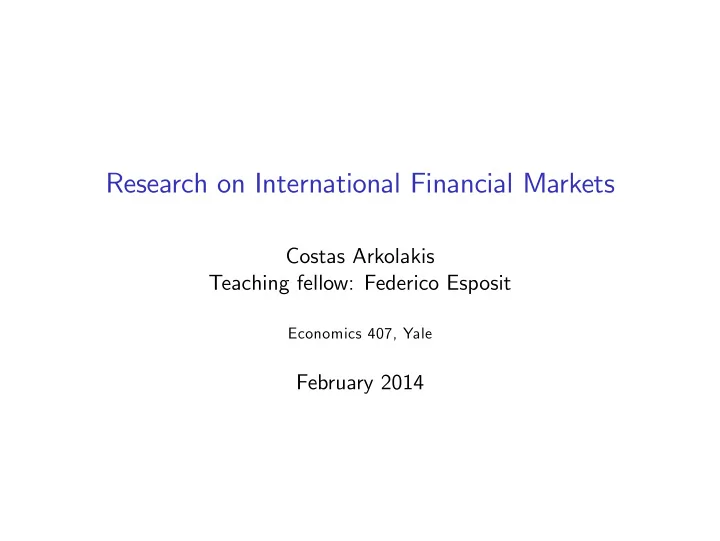

Research on International Financial Markets Costas Arkolakis Teaching fellow: Federico Esposit Economics 407, Yale February 2014
Complete vs Incomplete Markets Complete Market Hypothesis: A set of securities is available for every state of the world. � Allows you to invest when Marginal Product of capital is high: ‘Make Hay while the Sun Shines’ � In other words, invest when MPK � r � where r � is the world interest rate.
Complete vs Incomplete Markets Complete Market Hypothesis: A set of securities is available for every state of the world. � Allows you to invest when Marginal Product of capital is high: ‘Make Hay while the Sun Shines’ � In other words, invest when MPK � r � where r � is the world interest rate. Incomplete Market Hypothesis: No insurance for some states of the world. � Implies precautionary savings: ‘Save for the rainy days’ � In other words, invest when you have funds available.
Complete vs Incomplete Markets ) These two hypothesis lead to radically di¤erent conclusions as far as it concerns international …nancial markets. � With incomplete markets investment is based on availability of funds from savings. Savings and investment positively correlated � With complete markets you invest whenever investment returns are high . Savings and investment are uncorrelated
Feldstein Horioka (1980, Economic Journal) In 1980, Feldstein and Horioka showed that changes in countries’ rates of national savings were closely related to the countries’ rates of investment. � Examined 16 industrial countries over 1960-74. � Savings to GDP, Investment to GDP ratios
Feldstein Horioka (1980, Economic Journal)
Feldstein Horioka (1980, Economic Journal) Running a simple regression of investment to GDP on Savings to GDP on the cross-section of many countries, they obtained � I � � S � + ν 2 with R 2 = . 91 = . 035 + . 887 Y Y i i � The …nding is evidence for incomplete …nancial markets (e.g., imperfect capital mobility etc). � Not well integrated with the world capital markets; it implies corr ( S , I ) > 0 .
Feldstein Horioka (1980, Economic Journal) Running a simple regression of investment to GDP on Savings to GDP on the cross-section of many countries, they obtained � I � � S � + ν 2 with R 2 = . 91 = . 035 + . 887 Y Y i i � The …nding is evidence for incomplete …nancial markets (e.g., imperfect capital mobility etc). � Not well integrated with the world capital markets; it implies corr ( S , I ) > 0 . Bai & Zhang (2010, Econometrica) show that the standard model with � S � complete …nancial markets implies a regression coe¢cient on i close Y to zero ( corr ( S , I ) � 0)
Feldstein Horioka (1980, Economic Journal) Running a simple regression of investment to GDP on Savings to GDP on the cross-section of many countries, they obtained � I � � S � + ν 2 with R 2 = . 91 = . 035 + . 887 Y Y i i � The …nding is evidence for incomplete …nancial markets (e.g., imperfect capital mobility etc). � Not well integrated with the world capital markets; it implies corr ( S , I ) > 0 . Di¤erent regression coe¢cient on ‘true’ data and ‘complete markets’ model generated data. � The standard model cannot replicate the …ndings. We call this a “puzzle”.
Solving the Feldstein-Horioka Puzzle Bai and Zhang (2010, Econometrica) resolve this puzzle using incomplete markets. Postulate …nancial constraints: � They postulate a model where countries have restrictions on borrowing (a bond-enforcement model) � This speci…cation implies a restriction on capital ‡ow mobility � ! Capital ‡ows decline compared to the standard model; less risk-sharing.
Bai Zhang Results Figure: Simulations of the Incomplete Markets- Bond Enforcement Model. Source: Bai and Zhang (2010).
Recommend
More recommend